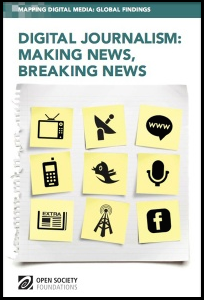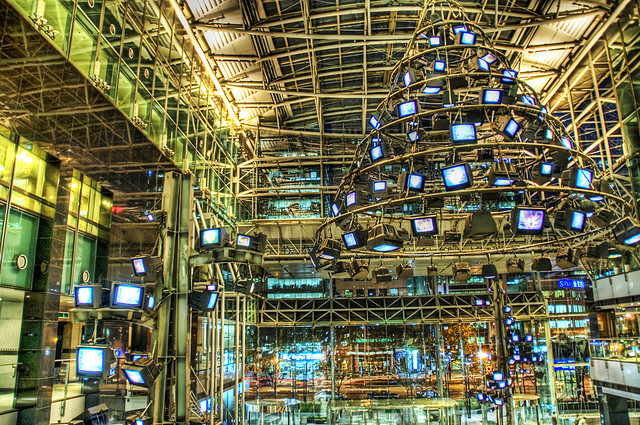 Editor’s Note: GIJN is pleased to present the first of a three-part series excerpted from Digital Journalism: Making News, Breaking News, a new report by the Open Society Foundation’s Independent Journalism and Information programs. The report summarizes the findings of OSF’s Mapping Digital Media project, the most extensive investigation of today’s media landscapes by any non-governmental organization, with more than 50 country reports since 2011. Its findings on the impact of digitization on media freedom and access to quality news are essential reading.
Editor’s Note: GIJN is pleased to present the first of a three-part series excerpted from Digital Journalism: Making News, Breaking News, a new report by the Open Society Foundation’s Independent Journalism and Information programs. The report summarizes the findings of OSF’s Mapping Digital Media project, the most extensive investigation of today’s media landscapes by any non-governmental organization, with more than 50 country reports since 2011. Its findings on the impact of digitization on media freedom and access to quality news are essential reading.
The Project
Over the course of the past decade, digital television and internet have brought about radical changes for media businesses, journalists, and citizens at large. Platforms distributing journalistic content have proliferated, technological advances have driven media companies to revamp their operations in the sometimes desperate attempt to remain lucrative and relevant, while journalists operate in an ever faster-paced industry, and citizens have access to a cornucopia of sources of news and information.
By the end of 2013, over 55 percent of households worldwide had a television set receiving digital signal, some 25 percentage points more than in 2008. In the developed world that figure stood at more than 81 percent. By the end of 2014, the world is forecast to number almost three billion internet users, two thirds of them in the developing world. With mobile phone saturation standing at nearly 100 percent of the global population, consumption on mobile platforms has surged dramatically as well. Mobile broadband subscriptions are predicted to reach 2.3 billion by the end of 2014.
But is this ever-more-connected world a better place for independent journalism? This is one of the questions that the Mapping Digital Media (MDM) project sought to answer.
The Program on Independent Journalism (PIJ), formerly the Media Program, and the Information Program at the Open Society Foundations launched MDM in 2011 as a global research and advocacy project that would assess the global opportunities and risks for journalism and media created by the switch from analog to digital broadcasting, the emergence of new media platforms—particularly online—and the convergence between internet, broadcasting, and telecommunications.
During 2011 and 2014, the project generated a total of 56 country reports authored by almost 200 local researchers coming chiefly from academia, journalism and civil society sector. The reports were based on a methodology common for the entire project. (See the Project Information.) The country reports were supplemented by 20 expert papers on specific new trends such as mobile television, net neutrality and online advertising.
The countries included in the project are diverse in terms of technological and economic development, media systems, and social background. They range from small nations with under one million souls such as Montenegro to giants like China and India, from heavily rural Chile and India to the city-state Singapore, from low GDP Kenya with under US$ 1,000 per capita to rich Sweden, Canada, Netherlands or the U.S. steadily advancing towards the US$ 50,000 threshold. They include overwhelmingly Muslim Pakistan, Tunisia and Turkey, the largely atheist Czech Republic, and many religiously diverse countries. The total combined population of all 56 countries included in the study surpasses 5.1 billion, almost three quarters of the globe’s people today. In total, Mapping Digital Media generated 5,575 pages of analysis. This publication gathers the main findings of the project.
Journalism in Digital Times
The Profession
Digitization has been one of the main drivers behind the changing nature of journalism as it affected news values, professional ethics, workflows, working conditions and newsroom management. On the positive side, it tremendously improved access to information and dissemination channels, but at the same time it has unleashed a spate of unethical practices, the most worrying being plagiarism and lack of verification.

Vancouver Pride Parade 2009. Will digital media reflect a diversity of voices? Credit: Creative Commons photo c/o M Sew (Flickr)
Investigative journalists in particular have gained access to a flurry of new platforms to put out their stories, particularly on the internet. However, in most countries, the social impact of journalistic investigations remains limited. As never before, citizens engage in investigations and reporting and post their write-ups on the internet, but in many cases the quality of these stories has come under critical scrutiny.
The biggest gain from digitization is the growing space for free expression by minority groups, particularly ethnic and sexual minorities. More than ever before, marginalized groups have the opportunity to make their voices heard. Paradoxically, however, traditional media have not significantly reduced their bias, marginalizing practices, or sensational coverage of minorities and other sensitive issues. Secondly, digitization has boosted more than ever before the space for political expression. Candidates in elections almost everywhere in the world use the internet and social media to reach voters. This has created more vibrant political debates and dialog, but it has not often translated into an increased number of political actors.
Overall, with all these ups and downs, journalism entered an era of opportunities that it has never had before. But how the environment journalists operate in has changed in the past years is a different story.
The Environment
With few exceptions (mostly in Europe), governments have bungled the policies and regulation governing digital switch-over. Coupled with the disarray of an industry hit by economic crisis, changing audiences and technology challenges, it did little to improve the environment in which journalism operates. Political wrangling and special interests and/or lack of vision and interest in the policy-making process have defeated the hopes that digitization would deliver a more diversified media. We have more channels, but not more owners—and sometimes fewer than before.
Public interest is rarely at the core of national digital switch-over policies. Public consultations are wholly lacking or, in some cases, a charade. Public media continue to suffer from political interference and funding cuts, as well as demoralization and uncertainty. Public service obligations outside public service media are rarely present. On the business side, media operators increasingly cut back funding for in-depth journalism as this content does not bring healthy returns. State advertising and advertorials compromising editorial independence are rife.
The outcome is an unprecedented crisis in the supply of public interest journalism— meaning journalism that is, independent, contextual, accountable, and relevant to citizenship.
Brave New Digital World: A Myth and A Waste
Although it was expected to create space for more players and voices, digitization has been almost everywhere an engine for faster consolidation and vertical integration, reinforcing the familiar problems of media markets. Thanks to the more efficient use of frequencies, digitization has freed transmission frequencies that were occupied by the old analog transmission and has thus made room for a much higher number of broadcasters than before. Practically, there are more frequencies available for broadcasters today in any given place than any functioning and robust market in the world can ever accommodate.
But despite this staggering resource opportunity, the number of players in most of the countries that have reached an advanced stage of the digital switch-over has not increased significantly as expected. Instead, you have the handful of old, dominant broadcasters running more channels than before and in many cases struggling to fill out the newly gained space and to pull in cash to cover this channel frenzy.
In most countries in the world, television remains the most popular medium in terms of audience size, followed by radio. There are exceptions such as Kenya (and other African countries) where radio and cell phones beat that. On the other hand, the increased use of other devices and platforms has not dented the television viewership. On the contrary, people increasingly watch television on multiple devices. In Europe, where television is the most used source of news, viewing time has spiked in recent years precisely thanks to new platforms and devices.
However, more means rather less in our times.
Astonishingly, after five or even ten years of transition to digital, there is no country in this project where a new television entrant has become the most popular channel. On the contrary: in all countries in Europe that have completed the digital transition, incumbent players have strengthened their position. Even worse, in some former members of the Soviet Union, there is a danger that the number of broadcasters may reduce, unable to keep up with the digital transition.

The world gets wired: An office building in Seoul. Credit: Creative Commons photo c/o Trey Ratcliff (Flickr).
Public service media are not faring better despite new opportunities created by digitization to expand their reach and capacity. In Europe, public service media are granted privileges in exchange for the responsibilities upon them. They receive funding to pay for upgrading production and transmission facilities as well as extra frequencies for which they do not had to pay or compete. However, for some public service media, particularly in countries where they struggle financially and are grappling with audience declines, the award of more frequencies is rather a burden as they lack the capacity, money, and in some cases also the vision to fill extra channels.
In countries where broadcast content offering has increased, this has not meant more quality and not at all more diversity either. What newly-licensed television channels often do is to recycle or replicate content on more channels at staggered hours.
This failure to inject fresh blood into media markets has been the result of badly planned digital licensing strategies, political barriers and governments and regulators that retain a discretionary power in awarding broadcast licenses, or the lack of interest in investing in new media outlets (this has happened in most of Latin America because digital television is a hefty and risky investment in poorer markets).
Generally, the attitude of regulators in disbursing digital frequencies is to sell them to the highest bidders, which favors incumbent actors and disadvantages local and community media. Government favoritism towards well-established broadcasters continues to guide the licensing policies in all of the countries outside north-western Europe, perpetuating habits from the old times when governments give licenses to media mostly to secure obedient and loyal coverage.
Policy-making on digital switch-over has mostly been led by industry and government, taking little account of public interest issues, and rarely involving civil society in any way. No public interest provisions were adopted in digital switch-over policies in almost two thirds of the MDM countries from Bulgaria and Georgia to Japan and Kazakhstan. In most of the countries, there is no civil society group able to engage in this debate or even to show interest in this issue.
In some countries, public consultation was bogus. In Hungary, the government called for public consultations on the digital switch-over strategy, but it did not use a word of the contributions received. In many places, such as Pakistan, Egypt or some in Southeast Asia, there is not even a plan for the digital switch-off. Procrastination has become a tactic for certain governments to minimize and conceal the opportunities created by digital switch-over, in order to deter new entrants and voices. So far, only a few countries, particularly those with strong public service media, have made diversity of channels a principle of their licensing policy. These countries are mostly Western and Northern European. Elsewhere, public service and state-administered broadcasters are undergoing profound crises. Their audiences are tumbling and they grapple with severe financial downturns.
Digitization has often been used by media companies to reinforce the argument for media consolidation. The argument goes that traditional media have to consolidate their operations under one roof to be able to remain lucrative in the digital market. Several countries have imposed tighter ceilings on concentration; ranging from Chile and Argentina in Latin America to Albania, Montenegro, Croatia, and the Czech Republic in Europe, and South Africa, most of these exceptional outcomes were the result of a long political struggle for media pluralism.
A major problem that the media sector has faced is the lack of transparency of media ownership and funding sources. Generally, there is little information on media owners and figureheads are often used to hide the actual entities that own media. Where legal provisions on transparency are in place, they are seldom enforced.
Thanks to reduced entry costs, new media ventures were launched mostly on the internet. They include commercial news portals as well as new forms of media such as hyper-local citizen media, media run by nongovernmental organizations (NGOs), and media funded by political and religious groups. However, only a few business models in this sector have been successful commercially and no pure-player (online-only) media outlet has yet taken the lead in audience-size over the biggest television, radio and press outlets. In many countries, the most trusted and visited websites among news providers are run by traditional media. This does not mean that traditional media have not been hit. Print newspapers have, with major exceptions, suffered the most.
In television, the growth in the number of channels (not owners) has not been matched by a surge in funding. At the same time, funding for media has become increasingly fragmented among more players and platforms. This has forced many media outlets to make cuts, affecting first of all and mostly in-depth journalism, a costly business that brings low (or no) returns. Instead, media focus increasingly on sensational content, which captures eyeballs and revenue. Moreover, the sector is in a desperate quest for new sources of money, some of which threaten journalistic independence. Advertorials not labeled as such or involvement of advertisers in shaping and framing content are common place in a number of countries ranging from Russia to Bosnia and Herzegovina to Mexico. In others such as Estonia, Chile or Latvia, product placement disguised as editorial content has been on the rise. In India, “private treaties” between media and advertisers are an industry norm, forcing journalists to refrain from criticizing advertisers.
But probably the most detrimental effect on independent journalism in recent years has been state advertising. With ad money shrinking or insufficient to support media markets and no new major sources of funding, state advertising money is often the lifebuoy for media companies in dire financial straits. Unfortunately, state ad money comes almost always with strings attached and is widely used to discriminate against independent, critical journalism. Examples abound from Pakistan to Georgia to South Africa to Colombia to Hungary to Spain.
Who Is Afraid of Telecoms?
The major novelty introduced by digitization is the increased importance of the transmission sector in the media market. Transmission companies have a major say in content production, program sale, distribution, transmission and access to content, and in equipment choice. Problems related to the gatekeeping role of the transmission providers are not widespread as yet. However, this is a contentious area as it offers a significant and cheap potential to bar access of media outlets to audiences (or vice versa).
As expected, telecommunications businesses have become a major player in this field. In most of the countries where digital switch-over has made progress, telcos became the natural player in digital transmission as they have the technical capability to run digital multiplexes (transmission facilities fit for distributing digital channels) or to deploy television over broadband, which is likely to become the most feasible form of carrying television content in the near future. With convergence of technologies and services leading to bundling of television, data and voice services in one package, telecoms and cable companies are increasingly operating in the same market and overall have become key players in distributing content.
However, when it comes to the actual impact of these new arrangements on media and journalists, fears that telecoms will emerge as a new pressure factor for news providers have proved groundless. There is not much evidence that these companies use their growing say in the media markets to make pressures on news providers to influence coverage. Moreover, the interest of telcos in entering media businesses has been frail to date; this is partly because telcos function according to a totally different business logic than that of media content providers, and partly because of the high level of risk that the media industry, more ravaged than other industries by the economic crisis, presents.
Nevertheless, in some countries, particularly developing states and countries undergoing democratization where flagship telcos are still state-controlled or have close links to state authorities, telcos are able to exert pressures on news providers and journalists on behalf of the authorities. Secondly, telcos, particularly mobile operators, are among the largest ad spenders everywhere in the world and are thus in a position to use their financial muscles to gag news providers and journalists. This has so far only happened in a few cases.
Digital Champions
Western and Northern Europe have the most progressive and fast-developing digital states in the world, thanks to the right kind of involvement by governments, supporting rather than reducing media independence. Finland is a leading force, with one of the highest levels of public support for the media per head and a broadcast licensing policy strongly favoring plurality and diversity.
Elsewhere, such examples are rare. In South-east Europe, Bosnia and Herzegovina has been praised for establishing a robust broadcast and telecom regulator, admittedly an institution that was imposed—and continues to be protected—by the international community. In the former Soviet Union, the picture outside the Baltic countries is rather grim. However, Georgia stands out for the creative use of internet tools in strengthening democracy and stirring debate. In Latin America, Uruguay received kudos for promoting transparency and staving off arbitrariness in licensing new broadcasters, a process intended to increase the number of voices in the television market, including community media for which the law reserves a third of the country’s frequencies. In South-east Asia, Singapore was authoritarian before digital technology and is more open today because of it, but it remains a laggard when it comes to freedom of expression. Indonesia is applauded for its open digital policy-making process. In the Arab world, Tunisia may be the country with the most promising prospects of using the switch-over to increase diversity in the media. But this promise has yet to be fulfilled.
What To Watch Next
Most of Europe has completed the digital switch-over. Latin America and Africa come next along with a number of countries in the Middle East and Asia that are waking up to the challenge. But overall, technology is advancing at a very rapid pace in this industry and broadband is increasingly emerging as the most feasible, economical and supple technology to carry television, likely to soon outperform terrestrial multiplex operators in many countries. Decisions on the choice of transmission have been generally random as no cost effectiveness or feasibility studies are ever conducted. As a result, governments made massive investments in distribution facilities that are not and are unlikely to be ever used.
In the short- to medium-term, policy debates in this field are likely to focus largely on the distribution of licenses and on ownership. There are few indications that anything will change in the pattern of regulating these issues as this process continues to be government- and industry-led as and civil society is little involved. Access to licenses for new entrants, including community media, a fair, transparent and open policy decision-making process, independent regulators and balanced ownership control in all digital media market segments are the factors that would help to create a healthier environment for journalism to operate. Standards and rules on all these issues should be central to the future media policies.
In the longer term, internet and mobile are—given the convergent nature of technology—the platforms most likely to be folded into a more inclusive media and communications policy. Online news is already governed by a set of growing set of laws and regulatory rules, mostly related to defamation, discrimination, or incitement to violence or hatred. In some countries, there are rules that badly hurt independent journalism. In others, government regulation infringes crassly on freedom of expression. In Africa, mobile is already a major communication tool. Elsewhere, content on mobile platforms is rapidly growing. Relaxed regulation of journalistic content on these platforms, along with obligations or incentives to carry public interest content and—as the third element—legislation to ensure balanced and diverse ownership: this combination should lie at the heart of a progressive media policy for the digitized media sector.
Reprinted with permission from the Open Society Foundations. The full report can be found here. Note: OSF is a donor to the Global Investigative Journalism Network.
 Marius Dragomir is senior manager and publications editor for the OSF Program on Independent Journalism. Previously, he worked for 17 years for Romanian and international media. He was a media critic with the Prague Business Journal, a columnist for the Czech Business Weekly, and field trainer for Transitions Online. In 2002, he was a fellow at the Wash., D.C.-based Atlantic Council, where he completed a thesis on media reform in post-communist Europe.
Marius Dragomir is senior manager and publications editor for the OSF Program on Independent Journalism. Previously, he worked for 17 years for Romanian and international media. He was a media critic with the Prague Business Journal, a columnist for the Czech Business Weekly, and field trainer for Transitions Online. In 2002, he was a fellow at the Wash., D.C.-based Atlantic Council, where he completed a thesis on media reform in post-communist Europe.
 Mark Thompson edits the www.mediapolicy.org website and research reports produced by the OSF Program on Independent Journalism. He has worked as a consultant for various governmental organizations and NGOs, a political officer for a UN peacekeeping mission, and a journalist, historian, and translator. Publications include Forging War (1999), Forging Peace (2002), The White War (2008), and Birth Certificate: The Story of Danilo Kis (2013).
Mark Thompson edits the www.mediapolicy.org website and research reports produced by the OSF Program on Independent Journalism. He has worked as a consultant for various governmental organizations and NGOs, a political officer for a UN peacekeeping mission, and a journalist, historian, and translator. Publications include Forging War (1999), Forging Peace (2002), The White War (2008), and Birth Certificate: The Story of Danilo Kis (2013).


